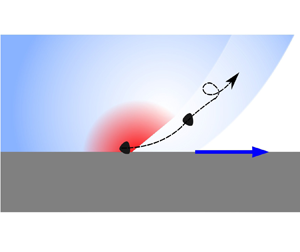No CrossRef data available.
Published online by Cambridge University Press: 25 November 2024

In spray cleaning, a multitude of small drops, violently accelerated by a high-speed gas stream, strike a dirty surface. This process is extremely effective: very little dirt can resist it. This is true even for dirt particles whose characteristic size is less than 100 nm. Spray cleaning is classically modelled by balancing particle adhesion with either inertial stress or viscous shear near the surface, the latter being calculated using droplet size and velocity as the characteristic length and velocity. This results in dimensionless numbers that are often well below one, suggesting that the mechanical stress exerted on the surface by the drop impact that detaches the particle is not well captured. Using quantitative nanoscale measurements, we show that the remarkable efficiency of spray cleaning results from the forced spreading of each droplet on the surface, which generates an unsteady and inhomogeneous shear confined to a boundary layer entrained in the wake of the liquid–solid contact line. In the very first moments of impact, the boundary layer is extremely thin, yielding a gigantic stress: the contact line of the spreading droplets sweeps all the surface particles away. We propose a quantitative model of spray cleaning based on this unsteady surface stress, which agrees well with (i) experimental data obtained with spray droplets of  $34\ \mathrm {\mu }$m mean radius impacting the surface to be cleaned at a mean velocity ranging between 30 and 70 m s
$34\ \mathrm {\mu }$m mean radius impacting the surface to be cleaned at a mean velocity ranging between 30 and 70 m s $^{-1}$ and contamination by nanoparticles of varying nature and shape and (ii) data in the literature on spray cleaning.
$^{-1}$ and contamination by nanoparticles of varying nature and shape and (ii) data in the literature on spray cleaning.